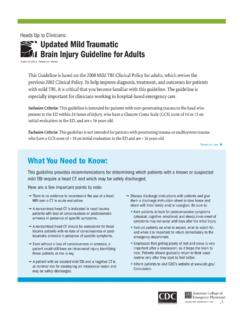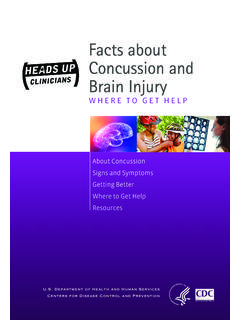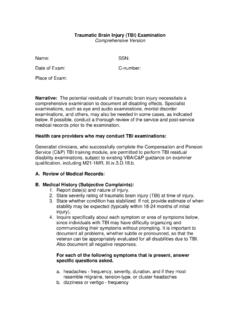Transcription of Cell Injury, Cell Death, and Adaptations - New Age Medical
1 1 Chapter 1 Cell injury , Cell Death, and AdaptationsExamples of Cell injury and NecrosisIschemic and Hypoxic InjuryIschemia-Reperfusion InjuryChemical (Toxic) InjuryApoptosisCauses of ApoptosisMechanisms of ApoptosisExamples of ApoptosisIntracellular AccumulationsPathologic CalcificationCellular AgingIntroduction to PathologyOverview of Cellular Responses to Stressand Noxious StimuliCellular Adaptations to StressHypertrophyHyperplasiaAtrophyMetap lasiaOverview of Cell injury and Cell DeathCauses of Cell InjuryThe Morphology of Cell and Tissue InjuryReversible InjuryNecrosisPatterns of Tissue NecrosisSubcellular Responses to InjuryMechanisms of Cell InjuryDepletion of ATPD amage to MitochondriaInflux of CalciumAccumulation of Oxygen-Derived Free Radicals(Oxidative Stress)Defects in Membrane PermeabilityDamage to DNA and Proteinsthe latter examines the particular responses of specializedorgans.
2 In this book we first cover the broad principlesof general pathology and then progress to specific diseaseprocesses in individual OF CELLULAR RESPONSES TOSTRESS AND NOXIOUS STIMULIC ells are active participants in their environment, con-stantly adjusting their structure and function to accom-modate changing demands and extracellular tend to maintain their intracellular milieu within afairly narrow range of physiologic parameters; that is,they maintain normal cells encounterphysiologic stresses or pathologic stimuli, they canundergo adaptation , achieving a new steady state andpreserving viability and function. The principal adaptiveINTRODUCTION TO PATHOLOGYL iterally translated, pathologyis the study (logos) of suf-fering (pathos). It is a discipline that bridges clinical prac-tice and basic science, and it involves the investigation ofthe causes (etiology) of disease as well as the underlyingmechanisms (pathogenesis) that result in the presentingsigns and symptoms of the patient.
3 Pathologists use avariety of molecular, microbiologic, and immunologictechniques to understand the biochemical, structural, andfunctional changes that occur in cells , tissues, and render diagnoses and guide therapy, pathologists iden-tify changes in the gross or microscopic appearance (mor-phology) of cells and tissues, and biochemical alterationsin body fluids (such as blood and urine). Traditionally,the discipline is divided into general pathology and sys-temic pathology; the former focuses on the fundamentalcellular and tissue responses to pathologic stimuli, while PROPERTY OF ELSEVIER SAMPLE CONTENT - NOT FINAL12 CHAPTER 1 Cell injury , cell death , and Adaptationsresponses are hypertrophy, hyperplasia, atrophy, the adaptive capability is exceeded or if theexternal stress is inherently harmful, cell injury develops(Fig.)
4 1 1). Within certain limits injury is reversible, andcells return to a stable baseline; however, severe or per-sistent stress results in irreversible injuryand death of theaffected cells . Cell deathis one of the most crucial eventsin the evolution of disease in any tissue or organ. It resultsfrom diverse causes, including ischemia (lack of bloodflow), infections, toxins, and immune reactions. Celldeath is also a normal and essential process in embryo-genesis, the development of organs, and the maintenanceof relationships between normal, adapted, andreversibly and irreversibly injured cells are well illustratedby the responses of the heart to different types of stress(Fig. 1 2). Myocardium subjected to persistent increasedload, as in hypertension or with a stenotic valve, adaptsby undergoing hypertrophy an increase in the size of the individual cells and ultimately the entire heart togenerate the required higher contractile force.
5 If theincreased demand is not relieved, or if the myocardiumis subjected to reduced blood flow (ischemia) from anoccluded coronary artery, the muscle cells may undergoinjury. Myocardium may be reversibly injured if the stressNORMAL CELL(homeostasis) Adaptations tress,increaseddemandInabilityto adaptCELL INJURYI njuriousstimulusREVERSIBLECELL INURYSUBCELLULARALTERATIONSNECROSISP oint of irreversibilityAPOPTOSISF igure 1 1 Stages in the cellular response to stress and injurious deathReversibly-injuredmyocyteNormal myocyteAdaptation:response toincreasedloadAdaptedmyocyte(hypertroph y)CellinjuryFigure 1 2 The relationship between normal, adapted, reversibly injured, and dead myocardial cells . The cellular adaptation depicted here is hyper-trophy, the type of reversible injury is ischemia, and the irreversible injury is ischemic coagulative necrosis.
6 In the example of myocardialhypertrophy (lower left), the left ventricular wall is thicker than 2 cm (normal, 1 cm). Reversibly injured myocardium shows functionaleffects without any gross or light microscopic changes, or reversible changes like cellular swelling and fatty change (shown here). In thespecimen showing necrosis (lower right) the transmural light area in the posterolateral left ventricle represents an acute myocardialinfarction. All three transverse sections of myocardium have been stained with triphenyltetrazolium chloride, an enzyme substrate thatcolors viable myocardium magenta. Failure to stain is due to enzyme loss after cell death . PROPERTY OF ELSEVIER SAMPLE CONTENT - NOT FINALCHAPTER 1 Cell injury , cell death , and Adaptations3 CFigure 1 3 Physiologic hypertrophy of the uterus during pregnancy.
7 A,Gross appearance of a normal uterus (right) and a gravid uterus (left) thatwas removed for postpartum bleeding. B,Small spindle-shaped uterine smooth muscle cells from a normal uterus. Compare this with (C)large, plump hypertrophied smooth muscle cells from a gravid uterus (B andC, same magnification).is mild or the arterial occlusion is incomplete or suffi-ciently brief, or it may undergo irreversible injury (infarc-tion) after complete or prolonged occlusion. Note, too,that stresses and injury affect not only the morphologybut also the functional status of cells and tissues. Thus,reversibly injured myocytes are not dead and may resemble normal myocytes morphologically; however,they are transiently noncontractile, and therefore, evenmild injury can have a lethal clinical impact.
8 Whether aspecific form of stress induces adaptation or causesreversible or irreversible injury depends not only on thenature and severity of the stress but also on several othervariables, including cellular metabolism, blood supply,and nutritional this chapter we discuss first how cells adapt tostresses and then the causes, mechanisms, and conse-quences of the various forms of acute cell damage, includ-ing reversible cell injury , subcellular alterations, and celldeath. We conclude with three other processes that affectcells and tissues: intracellular accumulations, pathologiccalcification, and cell Adaptations TO STRESSA daptations are reversible changes in the number, size,phenotype, metabolic activity, or functions of cells inresponse to changes in their environment.
9 Physiologicadaptationsusually represent responses of cells to normalstimulation by hormones or endogenous chemical medi-ators ( , the hormone-induced enlargement of thebreast and uterus during pregnancy). Pathologic adapta-tionsare responses to stress that allow cells to modulatetheir structure and function and thus escape injury . Suchadaptations can take several distinct is an increase in the size of cells resulting inincrease in the size of the contrast, hyperplasia(discussed next) is characterized by an increase in cellnumber. Stated another way, in pure hypertrophy thereare no new cells , just bigger cells , enlarged by anincreased amount of structural proteins and is an adaptive response in cells capable ofreplication, whereas hypertrophy occurs when cells areincapable of dividing.
10 Hypertrophy can be physiologic orpathologicand is caused either by increased functionaldemand or by specific hormonal stimulation. Hypertro-phy and hyperplasia can also occur together, and obvi-ously both result in an enlarged (hypertrophic) , the massive physiologic enlargement of the uterusduring pregnancy occurs as a consequence of estrogen-stimulated smooth muscle hypertrophy and smoothmuscle hyperplasia (Fig. 1 3). In contrast, the striatedmuscle cells in both the skeletal muscle and the heart canundergo only hypertrophy in response to increaseddemand because in the adult they have limited capacityto divide. Therefore, the avid weightlifter can develop arippled physique only by hypertrophy of individual skele-tal muscle cells induced by an increased workload.



